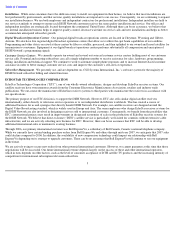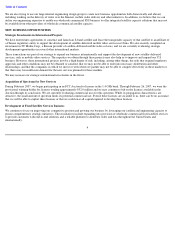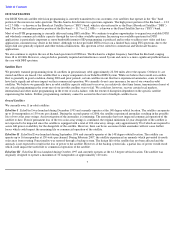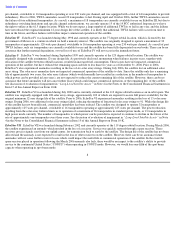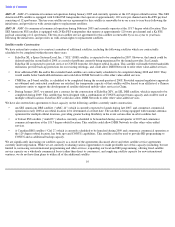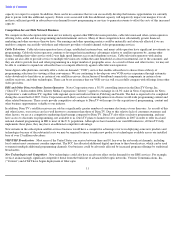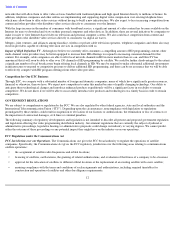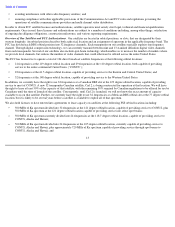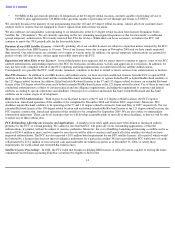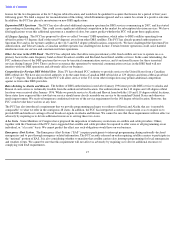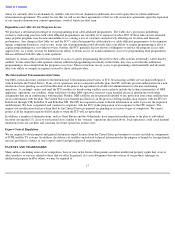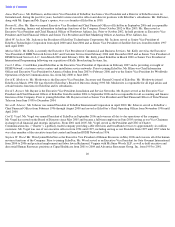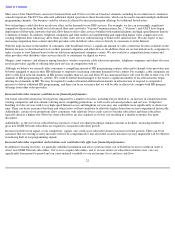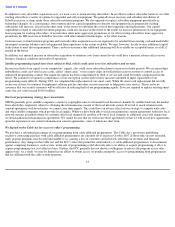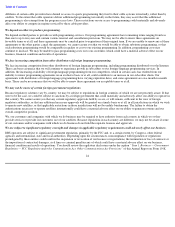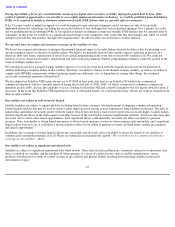Dish Network 2007 Annual Report Download - page 22
Download and view the complete annual report
Please find page 22 of the 2007 Dish Network annual report below. You can navigate through the pages in the report by either clicking on the pages listed below, or by using the keyword search tool below to find specific information within the annual report.
Table of Contents
license for the two frequencies at the 61.5 degree orbital location, and would not be qualified to acquire that license for a period of four years
following grant. We filed a request for reconsideration of this ruling, which Dominion opposed and we cannot be certain of a positive outcome.
In addition, the FCC has placed a moratorium on new DBS applications.
Expansion DBS Spectrum
. The FCC has also allocated additional expansion spectrum for DBS services commencing in 2007, and has started
a proceeding on licensing rules. This could create significant additional competition in the market for subscription television services. We have
filed applications to use this additional spectrum at a number of slots, but cannot predict whether the FCC will grant these applications.
4.5 Degree Spacing . The FCC has proposed to allow so-called “tweener” DBS operations, which refers to DBS satellites operating from
orbital locations 4.5 degrees (half of the usual 9 degrees) away from other DBS satellites. The FCC has already granted authorizations to
Spectrum Five and us for tweener satellites at the 114.5 and 86.5 degree orbital locations, respectively. We have challenged the Spectrum Five
authorization, and Telesat Canada, a Canadian satellite operator, has challenged our license. Certain tweener operations could cause harmful
interference into our service and constrain our future operations.
Other Services in the DBS Band . The FCC has adopted rules that allow non-geostationary orbit fixed satellite services to operate on a co-
primary basis in the same frequency band as direct broadcast satellite and Ku-band-based fixed satellite services. In the same rulemaking, the
FCC authorized use of the DBS spectrum that we use by terrestrial communication services, and it auctioned licenses for these terrestrial
services during January 2004. There can be no assurance that operations by terrestrial communication services in the DBS band will not
interfere with our DBS operations and adversely affect our business.
Competition for Foreign DBS Orbital Slots . DirecTV has obtained FCC authority to provide service to the United States from a Canadian
DBS orbital slot. We have also received authority to do the same from a Canadian DBS orbital slot at 129 degrees and from a Mexican orbital
slot at 77 degrees. The possibility that the FCC will allow service to the U.S. from other foreign slots may permit additional competition
against us from other DBS providers.
Rules Relating to Alaska and Hawaii
. The holders of DBS authorizations issued after January 1996 must provide DBS service to Alaska and
Hawaii if such service is technically feasible from the authorized orbital location. Our authorizations at the 110 degree and 148 degree orbital
locations were received after January 1996. While we provide service to Alaska and Hawaii from both the 110 and 119 degree orbital locations,
those states have expressed the view that our service should more closely resemble our service to the mainland United States and otherwise
needs improvement. We received temporary conditional waivers of the service requirement for the 148 degree orbital location. However, the
FCC could revoke these waivers at any time.
The FCC has also introduced a requirement that we provide programming packages to residents of Hawaii and Alaska that are “reasonably
comparable” to what we offer in the contiguous 48 states. In addition, the FCC has interpreted a statutory requirement so as to require us to
provide HD and multicast carriage of local broadcast signals in Alaska and Hawaii. We cannot be sure that these requirements will not affect us
adversely by requiring us to devote additional resources to serving these two states.
A La Carte
. Some Members of Congress have proposed the imposition of indecency restrictions on satellite and cable providers. Others,
together with the Chairman of the FCC, have suggested that satellite and cable providers be required to offer some or all programming on an
individual, or “a la carte” basis. We cannot predict the effect any such obligations would have on our business.
Emergency Alert System
. The Emergency Alert System (“EAS”) requires participants to interrupt programming during nationally-declared
emergencies and to pass through emergency-
related information. The FCC recently released an order requiring satellite carriers to participate in
the “national” portion of EAS. It is also considering whether to mandate that satellite carriers also interrupt programming for local emergencies
and weather events. We cannot be sure that this requirement will not affect us adversely by requiring us to devote additional resources to
complying with EAS requirements.
15


